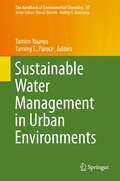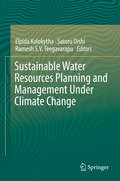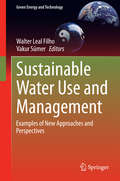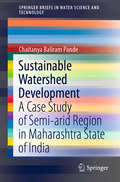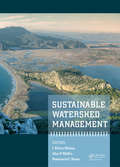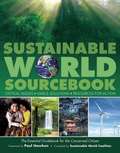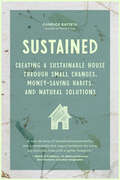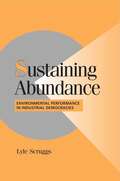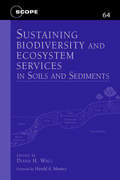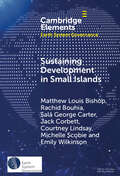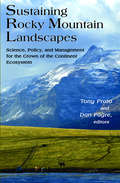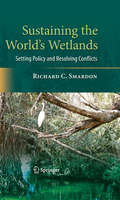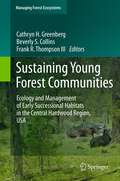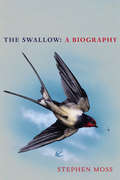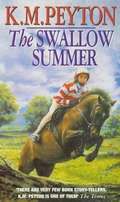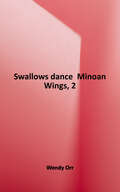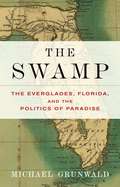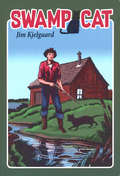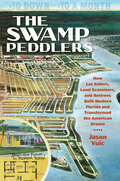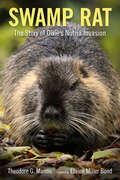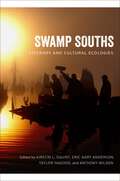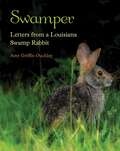- Table View
- List View
Sustainable Water Management in Urban Environments
by Tamim Younos Tammy E. PareceThisvolume focuses on practical aspects of sustainable water management in urbanareas and presents a discussion of key concepts, methodologies, and casestudies of innovative and evolving technologies. Topics include: (1) challengesin urban water resiliency; (2) water and energy nexus; (3) integrated urbanwater management; and (4) water reuse options (black water, gray water,rainwater). This volume serves as a useful reference for students andresearchers involved in holistic approaches to water management, and as avaluable guide to experts in governmental agencies as well as planners andengineers concerned with sustainable water management systems in urbanenvironments.
Sustainable Water Resources Planning and Management Under Climate Change
by Elpida Kolokytha Satoru Oishi Ramesh S.V. TeegavarapuThis book discusses different aspects of water resources, ranging from hydrology and modeling to management and policy responses. Climate changes and the uncertainty of future hydrological regimes make sustainable water resources management a difficult task, requiring a set of approaches that address climate variability and change. The book focuses on three main themes: hydrological changes, adaptive decision-making for water resources, and institutional analysis and risk management. It discusses the applications and limitations of climate change models and scenarios related to precipitation projection, which predicts to the future availability of water. It also offers interesting examples from around the globe to describe the policy options for dealing with climate change. Addressing emerging issues that need to be resolved and techniques that can be applied for sustainable climate-change-sensitive water resources protection and management, this practical, state-of-the-art reference book is a valuable resource for researchers, students and professionals interested in sustainable water resources management in a changing climate.
Sustainable Water Use and Management
by Walter Leal Filho Vakur SümerContributing to the growing debate on the need for sustainable water use and management, with concrete examples of new approaches, concepts, arguments, methods and findings which illustrate how this can be achieved, this book will be attractive for large groups of readers familiar with one or more of the themes it tackles, and to the general public. Within this context, the book makes use of many tables and graphics, which bring the many messages together. This approach is intended not only for those working on water matters (e. g. bureaucrats, water managers, policymakers, journalists, etc. ) and interested in water management issues and sustainability at large, but also for students of water management, water politics, environmental policy, water economics, water engineering and sustainability studies. Located at the crossroads of two key phenomena: sustainability and water, this book brings forward academic research and discussions on water efficiency, new technologies, and the water-agriculture nexus. It also benefits readers by tackling matters related to trans-boundary cooperation on water (including rainwater) and river-basin management, pricing issues, participatory water management, and the role of women in sustainable water use, amongst others.
Sustainable Watershed Development: A Case Study of Semi-arid Region in Maharashtra State of India (SpringerBriefs in Water Science and Technology)
by Chaitanya Baliram PandeThis book presents a case study on a semi-arid region, Maharashtra State, India, and discusses problems concerning a broad range of areas: sustainable watershed development; watershed management; groundwater condition; land and resource development plans; thematic maps on e.g. land use, soil types and soil erosion; groundwater recharge site selection; remote sensing and GIS; and soil and water conservation structures. The book’s focus is on creating a land and water resource development plan and environmental management for groundwater recharge development using remote sensing and GIS technology in the case study region, which is situated in the Akola and Buldhana districts of Maharashtra. Its goal is to promote awareness for sustainable watershed development and planning in semi-arid regions by highlighting the problems of, and plans for, groundwater and surface water pollution and sustainable watershed development. These aspects are of great importance to watershed and natural resources planning and management, and need to be exploited and managed sustainably. Given its scope, the book will be of interest to all scientists, research scholars and graduate students of remote sensing, hydrology, hydrogeology, water resource engineering, agricultural engineering and related areas who want to acquire detailed information on watershed planning and sustainable water resource planning in semi-arid regions, or to find new methodologies and techniques for studying the feedback mechanisms between forms and processes.
Sustainable Watershed Management
by I. Ethem Gönenç John P. Wolflin Rosemarie C. RussoThis proceedings volume contains papers and extended abstracts presented at the International Conference on Sustainable Watershed Management (SuWaMa 2014). The Conference was the second in a series of Sustainable Watershed Management Conferences. The objective of the Conference Series was to present and discuss advanced environmental models and con
Sustainable World SourceBook
by Sustainable World CoalitionThe Sustainable World SourceBook is designed to support readers in finding pathways for effective individual and group action. It cuts through the glut of information, providing a clear, concise overview of the most important issues and aspects of sustainability that everyone needs to know.
Sustained: Creating a Sustainable House Through Small Changes, Money-Saving Habits, and Natural Solutions
by Candice BatistaHelp Save Our Planet with Money-Saving Sustainable Tips for Your HouseHouseholds are among the biggest contributors to global greenhouse gas emissions worldwide. Could the secrets of saving the environment (and money) be closer to home than we thought?Looking for easy, budget-friendly ways to reduce your environmental impact and save money? Authored by award-winning environmental journalist, Candice Batista, Sustained takes you on an eye-opening journey towards sustainability and eco-friendly living─starting at home. This step-by-step, eco-living guide offers simple yet powerful ways to turn each room in your home into a hub of sustainability, while pocketing impressive savings every step of the way.Small changes, big impact. Starting with a deep dive into how our actions at home impact the planet, Sustained offers a practical suite of never-before-seen tools and solutions to initiate the shift towards a greener lifestyle–without draining your time, energy, or budget.Inside find:Eye-Opening Ideas: Explore green cleaning alternatives, ethical fashion brand recommendations, kitchen composting and waste management advice, laundry routine overhaul guidance, and more.Cleaner and Greener: Reduce your dependence on chemical products and single-use plastics, decipher cryptic food and fashion labels, shop like an eco-pro, and make room for a new lifestyle that’s kinder to you, your pocket, and the planet.Eco-Living Simplified: Going green doesn’t have to push your bank account into the red. Uncover tried-and-trusted tips for sustainable living, fresh recipe ideas, and up-to-date insights into top-rated biodegradable home products.Environmentally conscious readers of sustainability books like Simply Living Well, The Backyard Homestead Bible, or Sustainable Minimalism, will love Candice Batista's Sustained.
Sustaining Abundance: Environmental Performance in Industrial Democracies (Cambridge Studies in Comparative Politics)
by Lyle ScruggsThe ultimate goal of environmental policy is reducing pollution. Attention to environmental problems in the social sciences has brought some bold generalizations about causes of good results, but almost no systematic cross-national studies that flesh out major theoretical arguments and test those claims with data. This study makes a seminal contribution to that effort in two ways. First, by taking environmental outcomes over the last thirty years as the central dependent variable, it provides a basis for evaluating national performance in reducing environmental problems. Second, by developing a data set including performance in a number of countries and elaborating on major explanations of environmental performance found in the literature, this study provides the most rigorous available analysis of the determinants of environmental performance. In so doing, it challenges what is probably the conventional wisdom in the social sciences.
Sustaining Biodiversity and Ecosystem Services in Soils and Sediments (SCOPE Series #64)
by Diana H. WallSustaining Biodiversity and Ecosystem Services in Soils and Sediments brings together the world's leading ecologists, systematists, and evolutionary biologists to present scientific information that integrates soil and sediment disciplines across terrestrial, marine, and freshwater ecosystems. It offers a framework for a new discipline, one that will allow future scientists to consider the linkages of biodiversity below-surface, and how biota interact to provide the essential ecosystemservices needed for sustainable soils and sediments.Contributors consider key-questions regarding soils and sediments and the relationship between soil- and sediment- dwelling organisms and overall ecosystem functioning. The book is an important new synthesis for scientists and researchers studying a range of topics, including global sustainability, conservation biology, taxonomy, erosion, extreme systems, food production, and related fields. In addition, it provides new insight and understanding for managers, policymakers, and others concerned with global environmental sustainability and global change issues.
Sustaining Development in Small Islands: Climate Change, Geopolitical Security, and the Permissive Liberal Order (Elements in Earth System Governance)
by Matthew Louis Bishop Rachid Bouhia Salā George Carter Jack Corbett Courtney Lindsay Michelle Scobie Emily WilkinsonThe viability of small island developing states (SIDS) is threatened by three distinct processes – a backlash against globalisation; rising geopolitical competition between powers; and accelerating climate change – which are pulling at the threads binding the liberal international order together. We suggest that this order has been kinder to SIDS than is often acknowledged because its underpinning norms – sovereign equality, non-interference, and right to development – are inherently permissive and thus provide SIDS with choices rather than imperatives. Their leaders should fight for the continuation and enhancement of that order rather than be seduced by alternatives. We provide a rationale for and examples of policies to achieve this, including reforms to the way ODA is measured, debt restructured, climate finance allocated, and global governance organised. These enhancements represent the most plausible pathway for SIDS in a period of significant global upheaval. This title is also available as Open Access on Cambridge Core.
Sustaining Forests: A Development Strategy
by World BankThe World Bank's Forests Strategy, adopted in October 2002, charts a path for the Bank's proactive engagement in the sector to help attain the goal of poverty reduction without jeopardizing the environmental values intrinsic to sustainability. This strategy replaces the Bank's 1991 Forestry Strategy, and was developed on the basis of the findings of an independent review of the 1991 strategy and a two-year consultative process with development partners and stakeholders around the world. The revised strategy, Sustaining Forests, is built on three guiding pillars: harnessing the potential of forests to reduce poverty, integrating forests into sustainable economic development, and protecting global forest values. Recognizing the key role forests play in contributing to the livelihoods of people living in extreme poverty, government and local ownership of forest policies and interventions are emphasized along with the development of appropriate institutions to ensure good governance and the mainstreaming of forests into national development planning. The strategy also aims to support ecologically, socially and economically sound management of production forests by ensuring good management practices through application of safeguard procedures and independent monitoring and certification. Implementation of the strategy will center on building and strengthening partnerships with the private sector, non-governmental organizations, and other donor agencies to promote better forest conservation and management at country and global levels.
Sustaining Rocky Mountain Landscapes: Science, Policy, and Management for the Crown of the Continent Ecosystem
by Tony Prato Dan FagrePrato and Fagre offer the first systematic, multi-disciplinary assessment of the challenges involved in managing the Crown of the Continent Ecosystem (CCE), an area of the Rocky Mountains that includes northwestern Montana, southwestern Alberta, and southeastern British Columbia. The spectacular landscapes, extensive recreational options, and broad employment opportunities of the CCE have made it one of the fastest growing regions in the United States and Canada, and have lead to a shift in its economic base from extractive resources to service-oriented recreation and tourism industries. In the process, however, the amenities and attributes that draw people to this 'New West' are under threat. Pastoral scenes are disappearing as agricultural lands and other open spaces are converted to residential uses, biodiversity is endangered by the fragmentation of fish and wildlife habitats, and many areas are experiencing a decline in air and water quality. Sustaining Rocky Mountain Landscapes provides a scientific basis for communities to develop policies for managing the growth and economic transformation of the CCE without sacrificing the quality of life and environment for which the land is renowned. The book begins with a natural and economic history of the CCE. It follows with an assessment of current physical and biological conditions in the CCE. The contributors then explore how social, economic, demographic, and environmental forces are transforming ecosystem structure and function. They consider ecosystem change in response to changing patterns of land use, pollution, and drought; the increasing risk of wildfire to wildlife and to human life and property; and the implications of global climate change on the CCE. A final, policy-focused section of the book looks at transboundary issues in ecosystem management and evaluates the potential of community-based and adaptive approaches in ecosystem management.
Sustaining the World's Wetlands
by Richard SmardonWritten both as a textbook and as a professional reference book, Sustaining the World's Wetlands: Setting Policy and Resolving Conflicts contains detailed case studies of wetland management worldwide. Examinations of international wetland policy in Europe, Africa, Asia, and North America generate a discussion of the differences between wetland management issues in developed and developing countries, and culminate in suggested strategies for the future of wetland management. Key themes addressed in the case studies include the tradeoffs between sustainable use of wetlands for food, fuel, and fiber vs. the protection of ecosystem diversity and stability, and the respective roles of big international NGO's, national and regional government, and local community-based organizations when faced with wetland management issues. With its global scope and its emphasis on policy and management analysis, Sustaining the World's Wetlands is a unique and valuable tool both for students and for practitioners.
Sustaining Young Forest Communities
by Beverly Collins Frank Thompson III Cathryn GreenbergThis edited volume addresses a rising concern among natural resource scientists and management professionals about decline of the many plant and animal species associated with early-successional habitats, especially within the Central Hardwood Region of the USA. These open habitats, with herbaceous, shrub, or young forest cover, are disappearing as abandoned farmland, pastures, and cleared forest patches return to forest. There are many questions about "why, what, where, and how" to manage for early successional habitats. In this book, expert scientists and experienced land managers synthesize knowledge and original scientific work to address questions on such topics as wildlife, water, carbon sequestration, natural versus managed disturbance, future scenarios, and sustainable creation and management of early successional habitat in a landscape context.
Svalbard Imaginaries: The Making of an Arctic Archipelago (Arctic Encounters)
by Mathias Albert Dina Brode-Roger Lisbeth IversenBy drawing on a broad range of disciplinary backgrounds, this book illustrates the immense complexities of Svalbard as a place, point of reference, or social concept. It portrays the multiple, situated perspectives that characterize understandings and imaginings of Svalbard, and brings together contributions from academic fields that rarely interact with each other.Svalbard Imaginaries contributes to a number of research contexts, ranging from a broadly conceived, multi-disciplinary field of ‘Arctic Studies’ to more disciplinary specific debates on how places are reworked at the interstices of various global flows and vice versa. It assembles contributions on imaginaries that cover a wide array of issues, including—but not limited to—Svalbard as a geopolitical site, a landscape, an image, a (mining) heritage assemblage, a tourist destination, a wilderness, a built environment, a site of knowledge production, a site of artistic engagement, and projections of the future. It deliberately assembles analyses that refer to a variety of timescales and covers representations of the past, the present, and possible futures of Svalbard.
The Swallow: A Biography (Shortlisted for the Richard Jefferies Society and White Horse Bookshop Literary Award) (The Bird Biography Series #3)
by Stephen MossFrom the bestselling author of The Robin, The Wren and The Twelve Birds of Christmas. With around 700,000 breeding pairs, the swallow is one of the most familiar birds in Britain. Though we consider the swallow to be 'our' bird, we also share this beloved creature with millions of others across the globe. Whilst we see it on a daily basis for half the year, the swallow then flies south to Africa, living on only in our memory in the long, dark winter.In The Swallow Stephen Moss documents a year of observing the swallow close to home and in the field to shed light on the secret life of this extraordinary bird. We trace the swallow's life cycle and journey, including the epic 12,000-mile round trip it takes every year, to enable it to enjoy a life of almost eternal sunshine, and the key part the swallow plays in our traditional and popular culture.With beautiful illustrations throughout, this captivating year-in-the-life biography reveals the hidden secrets of this charismatic and beautiful bird.PRAISE FOR STEPHEN MOSS: 'A superb naturalist and writer' Chris Packham'Inspired, friendly and blessed with apparently limitless knowledge' Peter Marren'Moss has carved out an enviable niche as a chronicler of the natural world' Daily Mail
Swallow Summer (High Horse #2)
by K. M. Peyton'Loose horse! Loose horse!' 'It's Swallow!' shrieked Shrimp ... Summer has come to High Hawes, which means the annual Pony Club camp - and Rowan is terrified. She still hasn't managed to master wild Swallow, the spirited bay pony with a will of his own, and she's bound to humiliate herself in front of the brilliant Hawes family. But once at camp, even worse is to come when the future of the Hawes' riding school including Swallow - is threatened. To Rowan's horror, she realizes that her darling pony may. now have to be sold...
Swallow's Dance (Minoan Wings #Book Two)
by Wendy OrrA priestess by birth on the Bronze Age island that is now Santorini, Leira finds her coming-of-age training cut short when an earthquake destroys her town and leaves her powerful mother disabled. Warned by an oracle that worse is yet to come, the family flees to Crete but finds no sanctuary. A tsunami sends the island into anarchy and Leira must hide her noble status and learn new kinds of strength to help what remains of her family to survive.
The Swamp: The Everglades, Florida, and the Politics of Paradise
by Michael GrunwaldThe Everglades was once reviled as a liquid wasteland, and Americans dreamed of draining it. Now it is revered as a national treasure, and Americans have launched the largest environmental project in history to try to save it. The Swamp is the stunning story of the destruction and possible resurrection of the Everglades, the saga of man's abuse of nature in southern Florida and his unprecedented efforts to make amends. Michael Grunwald, a prize-winning national reporter for The Washington Post, takes readers on a riveting journey from the Ice Ages to the present, illuminating the natural, social and political history of one of America's most beguiling but least understood patches of land. The Everglades was America's last frontier, a wild country long after the West was won. Grunwald chronicles how a series of visionaries tried to drain and "reclaim" it, and how Mother Nature refused to bend to their will; in the most harrowing tale, a 1928 hurricane drowned 2,500 people in the Everglades. But the Army Corps of Engineers finally tamed the beast with levees and canals, converting half the Everglades into sprawling suburbs and sugar plantations. And though the southern Everglades was preserved as a national park, it soon deteriorated into an ecological mess. The River of Grass stopped flowing, and 90 percent of its wading birds vanished. Now America wants its swamp back. Grunwald shows how a new breed of visionaries transformed Everglades politics, producing the $8 billion rescue plan. That plan is already the blueprint for a new worldwide era of ecosystem restoration. And this book is a cautionary tale for that era. Through gripping narrative and dogged reporting, Grunwald shows how the Everglades is still threatened by the same hubris, greed and well-intentioned folly that led to its decline.
Swamp Cat
by Jim KjelgaardAn outstanding writer about the outdoors gives us two heroes in this fascinating book. One is a young boy who lives alone most happily on the edge of a swamp, earning his living from it. The other is, astonishingly, a black house cat. At least, Frosty started off as a city kitten, but by the time he proves his ability to survive the perils of the swamp wilderness and decides to share the boy's cabin with him, he is as much a part of his rugged environment as the deer, the horned owls, and the muskrats. The boy decides to stock the swamp with muskrats, without realizing that there are other enemies besides the predatory swamp creatures in this location where ancient family feuds have been allowed to hang on. There is the very feel of the wild country in all its moods, death-dealing or life-giving, and a wonderful closeness to the sensitive feelings and seesaw development of a boy. Edward Shenton's pictures are wonderful, as always.
Swamp Explorer (Into Reading, Level S #3)
by Kathleen SimpsonNIMAC-sourced textbook. Take a tour through a swamp and learn all about its features and creatures. Explore the swamp's food chains and learn how you can help take care of the swamps.
The Swamp Peddlers: How Lot Sellers, Land Scammers, and Retirees Built Modern Florida and Transformed the American Dream
by Jason VuicFlorida has long been a beacon for retirees, but for many, the American dream of owning a home there was a fantasy. That changed in the 1950s, when the so-called "installment land sales industry" hawked billions of dollars of Florida residential property, sight unseen, to retiring northerners. For only $10 down and $10 a month, working-class pensioners could buy a piece of the Florida dream: a graded home site that would be waiting for them in a planned community when they were ready to build. The result was Cape Coral, Port St. Lucie, Deltona, Port Charlotte, Palm Coast, and Spring Hill, among many others—sprawling communities with no downtowns, little industry, and millions of residential lots. In The Swamp Peddlers, Jason Vuic tells the raucous tale of the sale of residential lots in postwar Florida. Initially selling cheap homes to retirees with disposable income, by the mid-1950s developers realized that they could make more money selling parcels of land on installment to their customers. These "swamp peddlers" completely transformed the landscape and demographics of Florida, devastating the state environmentally by felling forests, draining wetlands, digging canals, and chopping up at least one million acres into grid-like subdivisions crisscrossed by thousands of miles of roads. Generations of northerners moved to Florida cheaply, but at a huge price: high-pressure sales tactics begat fraud; poor urban planning begat sprawl; poorly-regulated development begat environmental destruction, culminating in the perfect storm of the 21st-century subprime mortgage crisis.
Swamp Rat: The Story of Dixie's Nutria Invasion (America's Third Coast Series)
by Theodore G. MannoTheodore G. Manno traces the history of nutria from their natural range in South America to their status as an invasive species known for destroying the environmentally and economically important wetlands along the Gulf Coast. In this definitive book on “swamp rats,” Manno vividly recounts western expansion and the explosion of the American fur industry. Then he details an apocalyptic turn—to replace an overhunted beaver population in North America, humans introduced nutria. With an eclectic repertoire of true stories that read like fiction and are played out by larger-than-life characters, Manno conveys the legend of empire-seeking fur trappers, the bizarre miscommunications that led to nutria releases, and the sadness that comes with killing millions of nutria whose ancestors were never meant to leave their South American habitat. He tells of disastrous interactions among hungry nutria, storm surges from Hurricane Katrina, and major oil spills. His extensively researched and epic narrative, accompanied by more than thirty photographs and entertaining interviews with biologists, historians, fashion designers, and chefs, weaves a poignant tale of empire, conquest, fortune, and even Tabasco Sauce. Manno provides a full overview of what is currently known about nutria—a species now aggressively hunted with a bounty program because of their reputation for wetland destruction.
Swamp Souths: Literary and Cultural Ecologies
by Scott Romine Keely Byars-Nichols William Tynes Cowan Rain Prud'Homme-Cranford Josh-Wade Ferguson Hannah Godwin Peter Jay Ingrao Joseph Kuhn Lauren E. LaFauci John Wharton Lowe Rebecca Mark Jessica Martell Matthew E. Suazo Matthew Sutton Susan Thananopavarn Mitch Therieau Zackary VernonSwamp Souths: Literary and Cultural Ecologies expands the geographical scope of scholarship about southern swamps. Although the physical environments that form its central subjects are scattered throughout the southeastern United States—the Atchafalaya, the Okefenokee, the Mississippi River delta, the Everglades, and the Great Dismal Swamp—this evocative collection challenges fixed notions of place and foregrounds the ways in which ecosystems shape cultures and creations on both local and global scales. Across seventeen scholarly essays, along with a critical introduction and afterword, Swamp Souths introduces new frameworks for thinking about swamps in the South and beyond, with an emphasis on subjects including Indigenous studies, ecocriticism, intersectional feminism, and the tropical sublime. The volume analyzes canonical writers such as William Faulkner, Zora Neale Hurston, and Eudora Welty, but it also investigates contemporary literary works by Randall Kenan and Karen Russell, the films Beasts of the Southern Wild and My Louisiana Love, and music ranging from swamp rock and zydeco to Beyoncé’s visual album Lemonade. Navigating a complex assemblage of places and ecosystems, the contributors argue with passion and critical rigor for considering anew the literary and cultural work that swamps do. This dynamic collection of scholarship proves that swampy approaches to southern spaces possess increased relevance in an era of climate change and political crisis.
Swamper: Letters from a Louisiana Swamp Rabbit
by Amy Griffin OuchleySwamper, a fictitious swamp rabbit, lives in the bottomland hardwood forest, or overflow swamp, which is a very real environment. In twelve "letters" addressed to his human friends, Swamper shares his vivid observations about life in a Louisiana swamp. With excitement and captivating detail, he explains ecological concepts such as food webs, energy flow, decomposition, and reproduction. He recounts adventures like escaping his predators, the great horned owl and the red fox, and swimming for his life after a flood forces him to find higher ground. The alert swamp rabbit even describes the seasonal migration of birds and the monthly phases of the moon. While educating students about the interconnected life cycles found in a natural habitat, Swamper's first-hand account of the richness and value of the wetlands will also help young readers develop a deeper appreciation for this delicate ecosystem. Though written for all ages to enjoy, the content specifically aligns with life science and environmental science educational standards for 4th through 7th grades. Also Includes:A glossary of key termsQuestions and a creative activity for each letterBiologically accurate drawings of animals and habitatColor photographs of the environmentSupplementary online resources for teachers and parents
